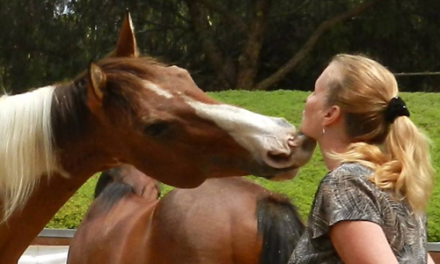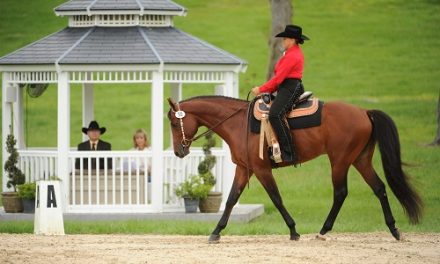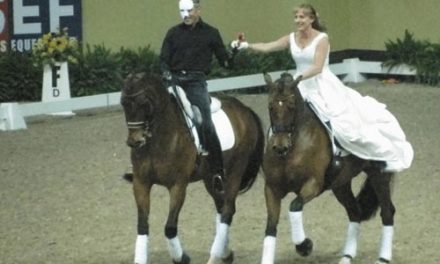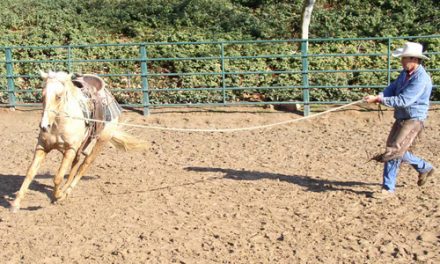Palm Partnership Training
 Often, riders who are unfamiliar with the discipline of dressage think of it as a pretentious style of riding that requires boring repetition to achieve the end result of riding pretty patterns. There are probably some of you reading this right now who are thinking, “What does dressage have to do with my discipline of Western Pleasure?” or “How can dressage help me and my horse on trail rides?” The truth is that dressage is simply a method of training that can improve the way any horse moves, and that in turn will improve his performance in, and attitude towards, any discipline.
Often, riders who are unfamiliar with the discipline of dressage think of it as a pretentious style of riding that requires boring repetition to achieve the end result of riding pretty patterns. There are probably some of you reading this right now who are thinking, “What does dressage have to do with my discipline of Western Pleasure?” or “How can dressage help me and my horse on trail rides?” The truth is that dressage is simply a method of training that can improve the way any horse moves, and that in turn will improve his performance in, and attitude towards, any discipline.
It wasn’t until the 1950s that American horsemen became interested in dressage as both a method of training and a competitive sport. Today, however, it is the fastest growing discipline in the country. Surely, all these converts cannot be “addicted” to something that is boring and just about riding patterns! So what exactly is dressage, and what makes it fascinating to so many riders?
The most inclusive definition of the object of dressage that I have found comes from a book first published in the U.S. in 1976, Dressage for Beginners, by R.L.V. French Blake. It was the definition of the British Horse Society at that time, but it holds true for my purposes today. The object of dressage is (parentheses my addition):
1. Harmonious development of the physique and ability of the horse. As a result it makes the horse calm (trail riding), supple (any discipline), loose and flexible, but also confident (trail riding and showing), attentive and keen, thus achieving perfect understanding with his rider.
2. These qualities are revealed by:
a. Freedom and regularity of the paces.
b. Harmony, lightness and ease of the movements.
c. Lightness of the forehand (jumping and all disciplines), and engagement of the hind quarters, originating in a lively impulsion (all disciplines).
d. The acceptance of the bridle (all disciplines), with submissiveness throughout, and without any tension or resistance.
3. The horse thus gives the impression of doing of his own accord what is required of him. Confident and attentive, he submits generously to the control of his rider, remaining absolutely straight in any movement on a straight line, and bending accordingly when moving on curved lines.
4. His walk is regular, free and unconstrained. His trot is free, light, and cadenced. His quarters are never inactive or sluggish; they respond to the slightest indication of the rider, and thereby give life and spirit to all the rest of his body.
5. By virtue of a lively impulsion and the suppleness of his joints, free from the paralyzing effects of resistance, the horse obeys willingly and without hesitation, and responds to the various aids calmly and with precision…
6. In all his work, even at the halt, the horse must be on the bit. A horse is “on the bit” when the hocks are correctly placed, the neck is more or less raised, according to the stage of training, and he accepts the bridle with a light and soft contact, and submissiveness throughout. The head should remain in a steady position, as a rule slightly in front of vertical, with a supple poll as the highest point of the neck, and no resistance should be offered to the rider.
That is what the objective of dressage training is all about, and what rider wouldn’t like a horse that meets the above description? The proper training of the horse is the primary goal in dressage.
The other side of dressage is the riding of a test before a judge, but, as Mr. Blake says, the test is incidental to the training. It is entirely possible for a rider and horse to train all the way through the top levels of dressage and never ride a test before a judge in a competition. However, competition is a good way to gage how well a horse is doing in his training, and it gives the rider an achievement goal beyond the satisfaction of a well-trained horse. A wonderful bonus of riding in a dressage competition is that the rider receives from the judge his written test form with each movement scored and with comments from the judge—something that is not done in any other equine competitive event!
Mr. Blake’s description of the goals of dressage may contain some terms with which you are unfamiliar. In the next newsletter, I will discuss the dressage training scale, otherwise known as the pyramid, and define the terms used in it. We will repeat those definitions in future newsletters when we discuss each level of dressage, its goals, and go over a test for that level.
After reading the above description of what dressage is, I hope you believe that dressage is for all breeds, all riders, and all disciplines. However, if you still have doubts, please stick with me on this and try some of the training techniques that will be discussed in upcoming newsletters. I am sure that you will be pleased with the results!
For more information about training courses, educational materials and much more, please visit www.lynnpalm.com or call 800-503-2824





